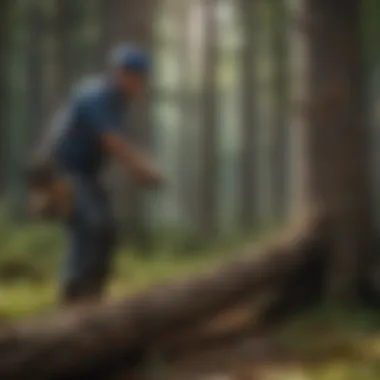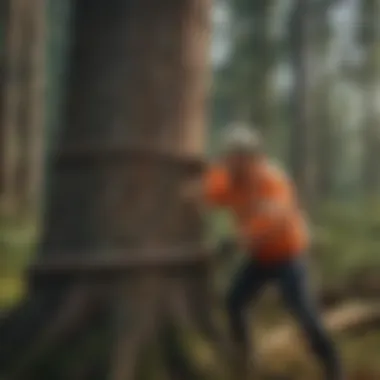Rope Techniques for Effective Tree Pulling


Intro
The use of ropes in tree pulling is a critical aspect of sustainable forestry management. Understanding its applications, techniques, and safety measures can enhance both the effectiveness and safety of tree-care practices. This approach not only aids in effective tree management but also contributes to the maintenance of healthy woodland ecosystems. The intertwining of proper techniques with a grasp of environmental influences sets the stage for informed decision-making and practical execution in forestry operations.
Understanding Woodland Ecosystems
Properly managing trees involves an appreciation for the ecosystems in which they exist. Woodlands are not just collections of trees but are complex systems housing diverse species and intricate relationships.
Importance of Biodiversity in Forests
Biodiversity plays a crucial role in maintaining forest health. A rich variety of species can enhance ecosystem resilience against pests and diseases. Additionally, diverse plant and animal life contributes to the overall productivity of the forest ecosystem, allowing it to flourish despite external pressures.
Role of Forests in Climate Regulation
Forests are significant players in climate regulation. They act as carbon sinks, absorbing CO2 from the atmosphere and mitigating climate change impacts. When employing ropes for pulling trees, recognizing their contribution to climate stabilization is essential. Effective tree management aligns with these natural processes, ensuring that pulling techniques do not disrupt the balance.
Sustainable Forestry Practices
Engagement in sustainable forestry practices is pivotal for tree management. These principles guide professionals in fostering both economic and environmental benefits.
Principles of Sustainable Forestry
Sustainable forestry revolves around maintaining forest health while allowing for responsible resource extraction. Key principles involve:
- Protection of biodiversity – Ensuring that diverse species thrive in their natural habitats.
- Soil conservation – Preventing soil degradation during logging operations.
- Water resource management – Safeguarding waterways from pollution and overuse.
Case Studies of Successful Implementations
Examining successful sustainable forestry cases provides valuable insights. For example, practices in the Pacific Northwest showcase methods that integrate local ecological knowledge with contemporary forestry science, leading to lasting positive outcomes in forest health and community well-being.
Woodland Stewardship Techniques
Forest stewardship extends beyond merely managing trees. It encompasses comprehensive strategies for maintaining overall ecosystem integrity and health.
Forest Management Plans
Developing a detailed forest management plan is paramount. Such plans should articulate long-term goals related to conservation, logging, and ecological restoration. Trends in the region's biodiversity and resource Health should be analyzed, guiding decisions on tree pulling techniques.
Conservation Strategies
Implementing conservation strategies ensures that tree pulling contributes positively to the environment. These strategies may include:
- Setting aside protected areas to conserve habitats.
- Regulating the timing and intensity of tree pulling to minimize disruption during critical growth periods.
- Collaborating with local communities to adopt traditional ecological knowledge into modern practices.
"Sustainable forestry is not just about what we cut, but how we cut it and its lasting impacts on the environment."
Understanding the balance between tree management and ecological integrity is essential for forestry professionals. It requires a meticulous approach to both techniques and applications of ropes in tree pulling.
Preamble to Tree Pulling
Tree pulling involves the removal or manipulation of trees through various methods, often using ropes and mechanical aids. This practice is essential in forestry for several reasons. Firstly, it helps in maintaining forest health by removing dead or diseased trees. Secondly, strategic pulling can promote growth by creating space for healthier trees to thrive. Understanding the processes and tools involved in tree pulling is vital for anyone engaged in forestry or tree management, as it leads to more effective and sustainable practices.
Understanding Tree Pulling
Tree pulling refers to the use of ropes and equipment to simplify the extraction or re-positioning of trees. This can be particularly useful in scenarios where trees are too large or heavy to move by hand. Some common applications include:
- Clearing land for construction
- Removing fallen trees from roads or properties
- Restructuring forests for better growth conditions
It's important that professionals understand the physics behind pulling trees. The direction of pull, angle, and type of equipment used all affect the success and safety of tree pulling operations.
Importance of Ropes in Tree Pulling


Ropes are fundamental components in the tree pulling process. Their ability to withstand heavy loads while providing control is essential. Selecting the right rope affects:
- Efficiency: A strong, durable rope can make the pulling process faster and more effective.
- Safety: The proper rope reduces the risk of breakage during operation, which could result in accidents.
- Versatility: Different types of ropes are suited for various conditions, making them valuable in diverse tree pulling scenarios.
In short, ropes contribute significantly to the execution of tree pulling, facilitating both precision and safety. In the next sections, we will explore the types of ropes available, how to select the appropriate one for specific tasks, and techniques employed in effective tree pulling.
Types of Ropes for Tree Pulling
Understanding the types of ropes available for tree pulling is crucial. Each type of rope has its unique properties, which affect its performance and suitability for different applications. The right choice of rope can significantly enhance efficiency, safety, and effectiveness in tree pulling operations. Making an informed decision about rope selection can also have long-term implications on the health of trees and the surrounding ecosystem.
Natural Fiber Ropes
Natural fiber ropes are made from materials like sisal, jute, or manila. These ropes provide good grip and flexibility, making them ideal for specific tasks. They are often biodegradable, which contributes to eco-friendliness. However, their durability can be a drawback, especially in wet or harsh conditions, which may limit their use in tree pulling. Users should consider the type of tree being pulled and the conditions to ensure that natural fiber ropes are suitable for the job.
Synthetic Ropes
Synthetic ropes are manufactured from various materials, providing higher durability and specialized features than natural fiber options. They often have increased resistance to weather elements, UV light, and abrasion. This section discusses three common types of synthetic ropes used in tree pulling:
Polypropylene Ropes
Polypropylene ropes are lightweight and float, making them popular in many outdoor applications. Their resistance to moisture makes them suitable for various environmental conditions. The key characteristic of polypropylene ropes is their low stretchability, which can be beneficial in certain pulling situations. However, their UV resistance is lower than other synthetic options, which could lead to degradation over time in sunlight.
Nylon Ropes
Nylon ropes are resilient and have excellent stretch, which can absorb shocks during tree pulling. This aspect can protect both the user and the equipment from sudden changes in tension. They are widely regarded as a versatile choice in many tree pulling scenarios due to their high strength-to-weight ratio. Despite this, nylon ropes can absorb water, making them prone to mold and mildew if not adequately maintained.
Polyester Ropes
Polyester ropes combine the best of both worlds, offering high strength and minimal stretch. This makes them suitable for applications requiring consistent performance without excessive elongation. They are often more resistant to UV damage than their nylon counterparts, providing longevity under outdoor conditions. However, polyester ropes can be stiffer, sometimes making them less manageable than other types, which may be a consideration for some users.
Specialty Ropes
Specialty ropes are designed for unique applications, addressing specific challenges encountered during tree pulling. These ropes can provide unique benefits that might be essential for certain jobs. Below are the types of specialty ropes worth discussing:
Dynamic Ropes
Dynamic ropes are engineered to absorb energy efficiently, making them ideal for situations where high shock loads may occur. These ropes excel in applications requiring safety, such as when tree pulling involves controlled descents. Their elasticity allows for gentle handling of trees and minimizes the strain on both the rope and the tree itself. However, the high elasticity can also make precise pulls more challenging and less effective.
Static Ropes
In contrast, static ropes are designed with minimal stretch, offering reliable safety during tree pulling tasks. They provide a solid connection, making them suitable for fixed-point operations where precision is critical. The key characteristic of static ropes is their ability to handle heavy loads without elongating. However, users must ensure they are familiar with proper techniques because the lack of stretch can lead to sudden shock impacts.
High-Visibility Ropes
High-visibility ropes are tailored for safety, often featuring bright colors to enhance visibility in various conditions. This quality is particularly advantageous in dense woodlands or low-light environments. Their contribution to safety is substantial, as they reduce the chances of accidents during tree pulling operations. While these ropes are often made from other materials like nylon or polyester, they facilitate easy detection and handling, which can save time and improve safety.
Selecting the Right Rope
Choosing the appropriate rope for tree pulling is crucial for effective and safe operation. The right type of rope can directly impact the efficiency of your pulling tasks and the safety of those involved. This section explores specific elements that influence this selection process, including pulling capacity, durability against environmental factors, and adherence to safety standards.
Assessing Pulling Capacity
When selecting a rope for tree pulling, the pulling capacity is a vital aspect to evaluate. This capacity refers to the maximum weight the rope can handle without breaking. Each type of rope has a different strength rating, often expressed in pounds or kilograms.
To accurately assess the necessary pulling capacity, consider these factors:
- Type of tree: Heavier trees require stronger ropes.
- Condition of the tree: Decaying or weak trees may reduce required strength, but safety is still paramount.
- Additional equipment: If tools like winches are utilized, their efficiency can affect the required capacity of the rope.
Calculating the required pulling strength is essential. It may involve a simple formula of weight plus a safety factor, which considers unexpected strains. Overall, understanding pulling capacity will prevent rope failure during use and ensure safe outcomes.
Durability and Weather Resistance
Durability and weather resistance are essential attributes for ropes used in outdoors tree pulling. Ropes will face various challenges including moisture, UV exposure, and extreme temperatures. Over time, these factors can degrade rope materials, compromising strength and safety.


When choosing a rope, consider the following durability aspects:
- Material: Synthetic ropes like Nylon and Polyester generally offer superior durability compared to natural fibers.
- Coating: Some ropes come with protective coatings to prevent abrasion and moisture infiltration.
- Maintenance: Regular inspection and cleaning can help extend rope life.
Ensuring that the selected rope can resist adverse weather effects is key to achieving long-lasting performance during repeated usage.
Safety Ratings and Standards
Understanding safety ratings and standards adds another layer of importance in selecting the proper rope for tree pulling. Reputed manufacturers will often provide detailed specifications to help users ensure their equipment meets specific safety criteria.
Key components to consider include:
- Breaking strength: Know the maximum force your rope can withstand without breaking.
- User certifications: Look for ropes that adhere to recognized safety standards, which often indicate a level of quality assurance.
- Rope diameter: Thicker ropes may carry additional safety benefits, but they may also be heavier and less flexible.
Observing these safety ratings put forth by organizations can significantly reduce risks when managing tree pulling tasks.
Effective selection of the right rope is the foundation of successful tree pulling practices, directly impacting safety, efficiency, and preservation of both tools and woodland.
In summary, selecting the right rope is not merely a matter of preference; it requires careful evaluation of specific characteristics. Considering pulling capacity ensures operational success. Durability and weather resistance protect your investment. Lastly, adherence to safety ratings safeguards everyone involved in tree pulling.
Techniques for Tree Pulling
The techniques utilized in tree pulling are fundamental to achieving effective and safe removal of trees. Their importance stems from ensuring the tree pulling process is efficient and minimizes damage to the surrounding environment and existing flora. By understanding various methods and tools, professionals can make informed decisions that impact not only the immediate area but also the long-term health of the ecosystem. In this section, we will explore the basic tree pulling methods, the use of winches and pulleys, as well as the application of tow straps and chains.
Basic Tree Pulling Methods
Basic tree pulling methods involve straightforward approaches that most beginners or casual enthusiasts can adopt. These methods can include manual pulling or the use of simple machinery. The core principle is leveraging force to uproot the tree while ensuring stability through proper positioning of the rope.
A simple yet effective method is to employ a strong rope tied securely around the trunk of the tree. Pulley systems can enhance force multiplication. This basic setup relies on using a durable rope that can withstand significant tension.
Key considerations include:
- Rope strength: Ensure the rope has a pulling capacity suitable for the size of the tree.
- Tree position: Evaluate the lean and position of the tree; this influences how much force is needed to pull it over.
- Ground conditions: Soft or uneven ground may require additional precautions to prevent slipping.
Utilizing Winches and Pulleys
Winches and pulleys bring a higher level of sophistication to tree pulling techniques. They allow for controlled pulling and can significantly reduce the physical strain on the operator. Winches are particularly advantageous for larger trees or when the terrain presents difficulty.
By connecting a winch cable to the tree and employing a pulley system, the effective pulling angle can be optimized. This method is especially useful for pulling trees in tight spaces where maneuverability is limited. The mechanical advantage of pulleys allows for easier handling of weight and enhances safety.
Considerations for using winches and pulleys include:
- Proper setup: Ensure the winch is anchored securely to prevent it from being pulled towards the tree.
- Understanding capacity: Winches have weight limits. Ensure it meets the demands of the task.
- Regular checks: Inspect the equipment for wear and damage before use.
Using Tow Straps and Chains
Tow straps and chains provide an alternative method for larger jobs or when dealing with trees that are particularly stubborn. Unlike traditional ropes, chains offer less stretch and can apply a more direct force, which may facilitate easier uprooting. Tow straps are also useful for situations where the tree's relocation is necessary rather than complete removal.
When using these tools, it is important to consider their connection points for safety and effectiveness. Chains must be secured properly to avoid any snap-back injury when tension is applied.
Before starting, check for:
- Anchor points: Ensure they are robust enough to handle the load.
- Equipment inspection: Look for kinks or damage that could compromise performance.
- Operator safety: Maintain a safe distance from the tree during the pulling process.
Overall, each of these techniques has unique benefits and considerations, and selecting the right one depends on the situation at hand. Understanding these methods and practicing them can greatly enhance the effectiveness and safety of tree pulling operations.
Safety Considerations
Safety is a fundamental aspect when it comes to tree pulling. The methods used in this activity can present various risks to both the individuals involved and the surrounding environment. Understanding the precautions that must be taken is crucial for successful and safe tree management. Proper safety considerations can minimize injuries and accidents while ensuring environmental integrity.
Personal Protective Equipment


Personal protective equipment (PPE) is essential when engaging in tree pulling activities. This equipment greatly reduces the risk of injury from potential hazards such as falling branches, heavy equipment, and sharp objects. Typical PPE includes:
- Hard Hats: To protect the head from falling debris.
- Safety Glasses: For eye protection against dust and particles.
- Gloves: To ensure a better grip and protect hands from cuts.
- Steel-Toed Boots: These provide foot protection against heavy weights and sharp objects.
- High-Visibility Clothing: Helps in being seen by others, especially in areas where heavy machinery is operational.
By wearing proper PPE, individuals can safeguard themselves from injuries that may occur during the process of pulling trees. It is also advisable to inspect PPE regularly for wear and tear, ensuring optimal effectiveness.
Risk Assessment
Conducting a thorough risk assessment before beginning tree pulling can reveal potential hazards and inform necessary precautions. Assessing risks involves identifying possible dangers and evaluating their severity and likelihood. Steps in a risk assessment include:
- Site Inspection: Examine the area for unstable ground, nearby structures, and environmental conditions.
- Identifying Hazards: Look for hazards such as nearby power lines, unstable trees, and possible wildlife.
- Evaluating Risks: Determine how likely each identified hazard is to cause an accident and the potential consequences.
- Implementing Control Measures: Based on your assessment, implement strategies to mitigate identified risks. This may include designating safe zones or using barriers.
A well-thought-out risk assessment not only prepares a team for possible dangers but also can improve efficiency by ensuring all members understand the risks involved.
Emergency Procedures
Having clear emergency procedures is vital in any tree pulling operation. Even with the best precautions, accidents can happen. Established procedures can facilitate a quick and effective response. Essential elements of emergency procedures include:
- Establishing Communication: Ensure all team members know who to contact in case of an emergency and how to reach them.
- Reporting Protocols: Outline methods for reporting incidents or injuries, such as notifying a supervisor or calling emergency services.
- First Aid: Have a trained first aid responder on-site and a stocked first aid kit readily available. Make sure all team members know its location.
- Evacuation Plan: Develop a clear evacuation plan that all members are familiar with. This should include designated safe areas and a headcount procedure to ensure all team members are present.
Adhering to these emergency procedures can significantly reduce the impact of accidents and ensure that help is administered promptly.
"Safety is not just a priority; it is a collective responsibility that requires ongoing vigilance and commitment from all members of a tree pulling team."
By understanding and implementing these safety considerations, tree pulling can be conducted in a manner that prioritizes the well-being of individuals and the surroundings. These practices not only safeguard personnel but also promote sustainable and responsible forest management.
Environmental Impact of Tree Pulling
Understanding the environmental impact of tree pulling is essential for sustainable forestry practices. When trees are pulled, the method can have various effects on the ecosystem. It is critical to evaluate these impacts to ensure that tree management practices are responsible and promote biodiversity. By considering the environmental ramifications, professionals can mitigate negative outcomes and implement more effective techniques.
Ecosystem Balance
Tree pulling can disrupt the natural ecosystem balance, which is vital for maintaining forest health. When a tree is removed, it can lead to changes in the habitat for numerous organisms. This impact is not limited to the tree itself, but extends to the soil, air quality, and surrounding flora and fauna.
- Soil Disruption: The removal of a tree can disturb the soil structure, leading to changes in how nutrients are absorbed. Microorganisms that depend on tree roots for stability and nutrients may be adversely affected.
- Habitat Loss: Many species rely on trees for shelter and food. Removing one tree could impact birds, insects, and mammals that are part of the local ecosystem. Even the smallest organisms play a critical role in the ecosystem, hence their loss should not be taken lightly.
"Sustainable forestry practices can mitigate the disruptive impacts of tree pulling by ensuring that the ecological balance is maintained."
Soil Erosion Prevention
Soil erosion is a pressing concern associated with tree pulling. Trees help anchor soil, preventing it from being washed or blown away. When trees are pulled without careful consideration, the risk of erosion increases dramatically.
- Topsoil Loss: The upper layer of soil is rich in organic matter and nutrients. Its loss can lead to reduced fertility, hindering plant growth and degrading the site's ecological integrity.
- Water Runoff: Without trees, rainwater can lead to rapid runoff, which not only causes erosion but can also increase the likelihood of flooding. Captured water runoff can carry pollutants, further degrading local waterways.
To prevent erosion, forestry professionals should consider controlled tree removal techniques and implement measures such as planting cover crops or installing barriers that help retain soil structure.
Species Protection
Species protection is crucial in any tree pulling operation. The focus should be on conserving species that may be vulnerable or endangered. When deciding to pull a tree, it is essential to consider not just the tree itself but the entire community of organisms that depend on that tree for survival.
- Biodiversity: A diverse ecosystem is more resilient to changes. Its loss can have cascading effects, leading to extinction of species that are unable to adapt swiftly to altered conditions.
- Conservation Strategies: Implementing conservation strategies that include habitat protection can greatly help in maintaining species numbers. These strategies might involve areas where tree pulling is restricted to ensure that crucial habitats remain intact.
Professionals who engage in tree pulling must prioritize species protection to foster a healthier ecological system while conducting necessary forestry tasks.
Closure
The conclusion is a vital part of this article on rope for tree pulling. It synthesizes the information provided in previous sections, offering a final reflection on the significance of tree pulling within sustainable forestry practices. Understanding the appropriate techniques and types of ropes enhances not only the efficacy of tree management but also establishes a responsible approach to preserving natural habitats.
Summary of Key Points
In this article, we examined various aspects of tree pulling with a focus on ropes. Here are the essential points:
- Types of Ropes: We covered the key types of ropes used in tree pulling, including natural fibers, synthetic options, and specialty ropes. Each type has its unique properties and uses.
- Selecting the Right Rope: The importance of assessing pulling capacity, durability, and safety ratings was discussed. These factors play a critical role in ensuring successful tree pulling operations.
- Techniques for Pulling: Basic methods and advanced techniques involving winches, pulleys, and tow straps were highlighted. This variety allows for adaptability based on specific job requirements.
- Safety Considerations: We emphasized personal protective equipment, risk assessment, and emergency procedures to mitigate potential hazards.
- Environmental Impact: Recognizing the ecological aspects is crucial for maintaining ecosystem balance, preventing soil erosion, and protecting various species.
Future Considerations in Tree Pulling Practices
Looking forward, several considerations could shape the future of tree pulling practices:
- Innovation in Ropes: Advances in materials and technology could lead to the development of more durable and lightweight ropes, enhancing efficiency and safety.
- Sustainability Practices: Trends in sustainable forestry will drive the need for tree pulling methods that consider environmental impacts. This includes minimizing soil disturbance and protecting biodiversity.
- Training and Education: Increasing emphasis on professional development in tree pulling techniques can enhance worker safety and proper rope use.







